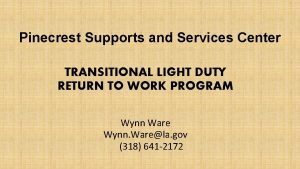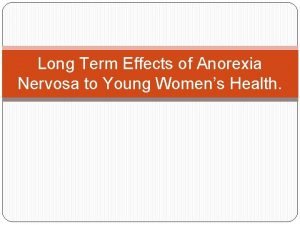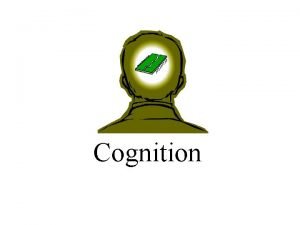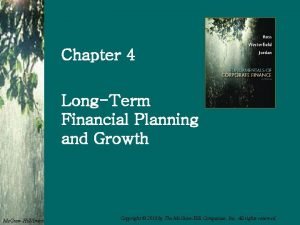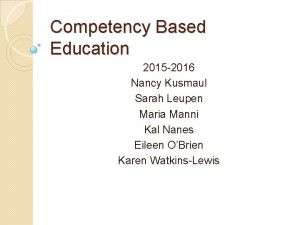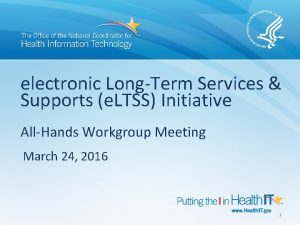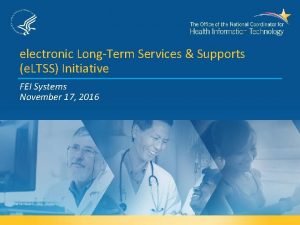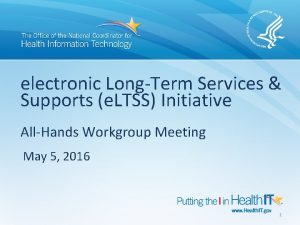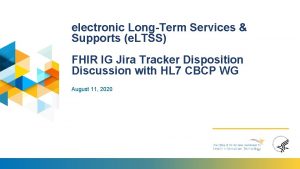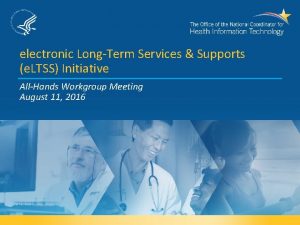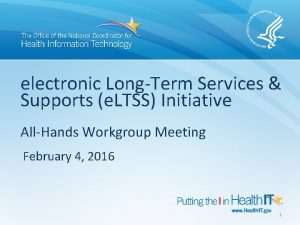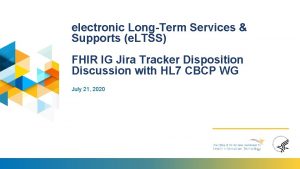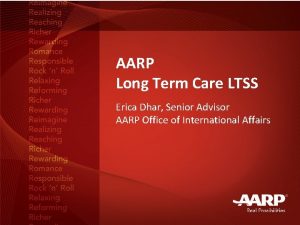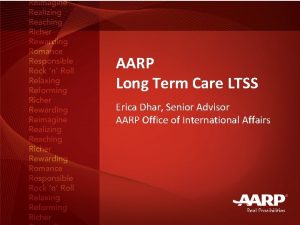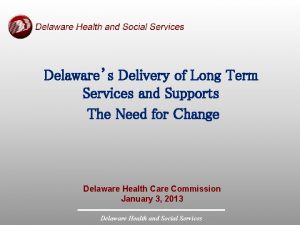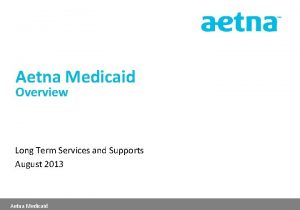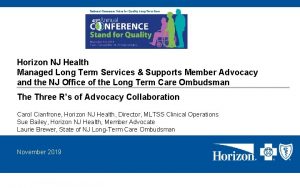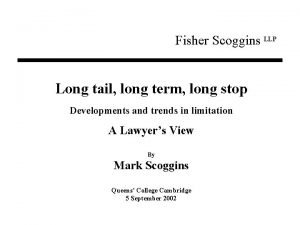LONG TERM SERVICES AND SUPPORTS LTSS NANCY KUSMAUL



















- Slides: 19

LONG TERM SERVICES AND SUPPORTS (LTSS) NANCY KUSMAUL, PHD, MSW OCTOBER 2, 2019

CASE STUDY • Ray, age 80, and his wife Jean, age 75, have been married for over 50 years. He suffered a stroke several years ago and also has diabetes and CHF. Jean takes of Ray at home, with the help of two of her four children and occasional assistance from a home health agency. • Ray is difficult to care for at home. He is heavy, and he is partially paralyzed on the left, making mobility difficult. He adamantly refuses to consider going to a nursing home. Caring for Ray exacerbates Jean’s arthritis and leaves her in chronic pain. She feels like she has to care for Ray, as her own mother cared for her father when he became frail and infirm.

GROUNDING QUESTIONS • What do I need to know to take the best care of you possible? • Life Goals • Care Goals • Who needs to know this information? • Patient Physicians • Pharmacists • Family caregivers • Specialists • Who else? • Direct Care workers • Social Workers • Why? • Nurses • Therapists • Primary Care • Care coordinators

WHAT ARE LONG TERM SERVICES AND SUPPORTS? • A broad range of supportive services provided by professionals (formal care) and family and friends (informal care). • Informal Caregivers (unpaid assistance) • Family, friends, neighbors, etc. • Formal Care Services (paid assistance) • • • Home and Community-based Services (HCBS) Assisted living Continuing Care Retirement Communities (CCRCs) Adult Day Care Nursing homes

WHO RECEIVES LONG TERM SERVICES AND SUPPORTS? • LTSS are provided to people who need assistance to perform routine daily activities over an extended period due to disability or chronic illness. • Goal of integrating supports and medical care to maintain health, improve functional capacity, enhance physical, social and emotional well-being, and maximize autonomy.

HOW MANY RECEIVE LTSS? • About one-third of people 65 + and two-thirds of those 85 + experience functional limitations that require assistance (Marquand & York, 2016). • Of the 80 million adults 65 + anticipated by 2040, 29 million will have some sort of disability (Agbonifo, Hittle, Suarez & Davis, 2017) • Many of these individuals will remain at home and receive most of their assistance from family caregivers (Seavey & Marquand, 2011). • The availability of unpaid family caregivers is decreasing with rising employment among women, smaller family sizes, increased childlessness and higher divorce rates (Johnson & Wiener, 2006. )

LTSS FINANCING • Medicaid is the primary payer for LTSS • Of total LTSS spending in 2013: • 51% Medicaid • 21% Other public funds • 19% Out-of-pocket • 8% Private insurance

MEDICARE • Does NOT cover LTSS except short-term with a skilled need like rehab • This is often a surprise to older adults and their families

ADLS AND IADLS • ADLs: Basic functional tasks • Bathing, dressing, toileting, transferring, continence, feeding • IADLs: More complex tasks required for independent living • Using the telephone, shopping, food preparation, housekeeping, laundry, transportation, medication management, handling finances • ADL and IADL assessments are often used to determine the need for LTSS and payments for services

HOME AND COMMUNITY-BASED SERVICES (HCBS) • Services provided through Medicaid, other state services, or private pay to individuals within their own home/community • Support choice and independence of older adults and adults with disabilities • Includes medical and non-medical services, such as case management, homemaker, home health, personal care, adult day services, and respite care

RESPITE CARE • Provides relief of caregiving responsibilities on a temporary or periodic basis • Services can include: adult day care, case managers, thorough assessment and counseling, in-home services, support groups, education, training materials

ADULT DAY CARE • Adult day care centers provide a variety of services to meet the needs of participants and family members • Is an alternative to nursing homes or assisted living • Older adults continue living in their home, but come to an adult day care center during the day

WHAT SERVICES PROVIDED AT ADULT DAY? • Services to address ADLs, nursing and other medical needs, psychosocial care, meals, and programs for caregiver well-being and support • Assistance with walking, toileting, meals, bathing, blood pressure monitoring, weight monitoring, medication management, diabetes monitoring • Specific services depend on medical vs social adult day

ASSISTED LIVING (AL) • According to the Assisted Living Coalition, AL is: • A congregate residential setting that provides or coordinates personal services, 24 -hour supervision and assistance, activities, and health related services. • Less government regulation and financing than nursing homes (State specific) • Goals include: accommodate residents’ changing needs and preferences; maximize residents’ dignity, autonomy, and independence; and encourage family and community involvement

KEY ASSISTED LIVING STATISTICS • Are currently 22, 000 assisted living residences (and similar residential care communities) in the US housing more than 700, 000 residents • Most pay out-of-pocket for assisted living: • Average private-pay annual rate for a private room with a private bath was about $41, 000, with rates for those in dementia specific communities averaging $54, 000 • Some require security deposits, one-time community fees • There are significant regional variations in cost

CONDITIONS OF AL RESIDENTS • Based on the National Survey of Residential Care Facilities (NSRCF), the ten most frequent conditions were: • high blood pressure, Alzheimer's disease/other dementias, heart disease, depression, arthritis, osteoporosis, diabetes, COPD, cancer, and stroke. • About a quarter of residents (26 percent) had 4 -10 chronic health conditions.

CONTINUING CARE RETIREMENT COMMUNITY (CCRC) • A residential community that older adults move to for the rest of their lives. • Residents can move between levels of care (independent living, assisted living, skilled nursing) within one complex based on care needs • Approximately 2, 240 CCRCs in the US housing more than 745, 000 older adults

NURSING HOMES • Skilled Nursing Facilities or Nursing Centers • Facilities with 3 or more beds for residents who need assistance and supervision 24 hours/day by health professionals due to physical health problems, functional disabilities, and/or significant cognitive impairments • Only 4% of the population 65 and older live in NHs • ~1. 5 million people total

REFERENCES • Agbonifo, N. , Hittle, B. Suarez, R. & Davis K. (2017). Occupational exposures of home Healthcare Nurse, 35, 50 -159. healthcare workers. Home • Compendium of Residential Care and Assisted Living Regulations and Policy: 2015 Edition https: //aspe. hhs. gov/basic-report/compendium-residential-care-and-assisted-living-regulations-and-policy-2015 edition#intro • Johnson, R. W. & Wiener, J. M. (2006). A profile of frail older Americans and their caregivers. Washington DC: The Urban Institute. • Khatutsky G, Ormond C, Wiener JM, Greene AM, Johnson R, Jessup EA, Vreeland E, Sengupta M, Caffrey C, Harris -Kojetin L. Residential care communities and their residents in 2010: A national portrait. DHHS Publication No. 20161041. Hyattsville, MD: National Center for Health Statistics. 2016. • Marquand, A. & York, A. (2016). Squaring to the challenge: Who will be tomorrow’s caregivers? Generations, 40, 1017. • Seavey, D. & Marquand A. (2011). Caring in America: A comprehensive analysis of the nation’s fastest-growing jobs: Home health and personal care aides. New York City: PHI.
 Short, medium and long term planning in education
Short, medium and long term planning in education Short term human resource planning
Short term human resource planning Difference between long term and short term liabilities
Difference between long term and short term liabilities Difference between long term and short term liabilities
Difference between long term and short term liabilities Long term goals examples for freshers
Long term goals examples for freshers Long term and short term financial planning
Long term and short term financial planning Long term memory vs short term memory
Long term memory vs short term memory Short short short long long long short short short
Short short short long long long short short short Once upon a time there lived an old man and an old woman
Once upon a time there lived an old man and an old woman Pinecrest supports and services center
Pinecrest supports and services center Long term storage and retrieval
Long term storage and retrieval Anorexia nervosa consequences long term
Anorexia nervosa consequences long term Long term storage and retrieval
Long term storage and retrieval Long term objectives and strategies
Long term objectives and strategies Features of preferred stock
Features of preferred stock Long term financial planning and growth chapter 4
Long term financial planning and growth chapter 4 Internal growth rate formula
Internal growth rate formula Short term loans and advances
Short term loans and advances Pull questions
Pull questions Long term financial planning and growth
Long term financial planning and growth









